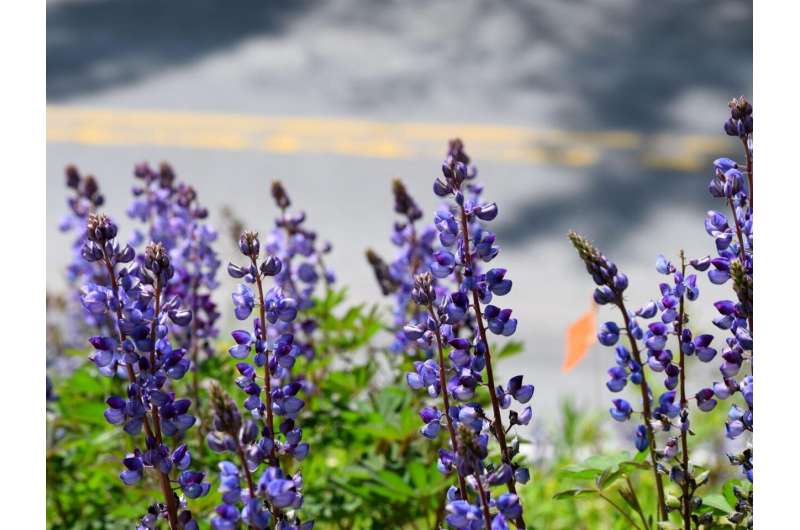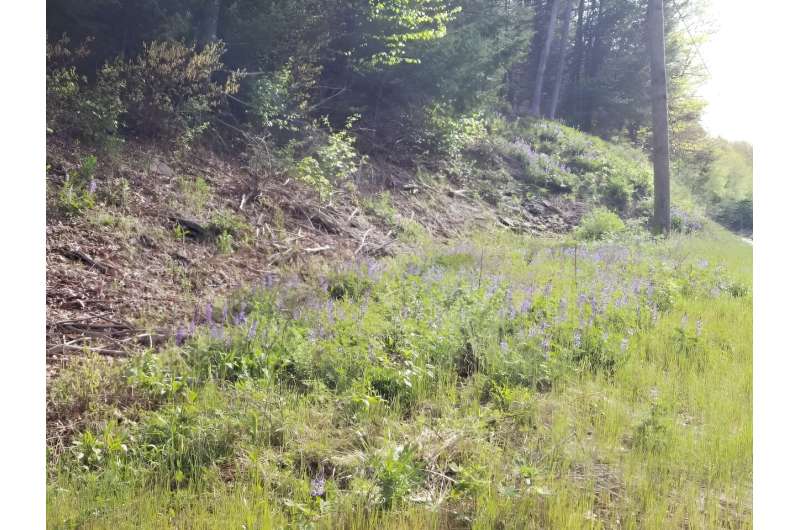Wild lupine, a plant of conservation concern across most of its natural range in eastern North America, grows along a Pennsylvania roadside. Credit: Isabella Petitta
Managing forest edge habitats to maintain a gradient of canopy cover and plant density could be key to conserving some threatened native plant species such as wild lupine, according to Penn State researchers.
Edge habitats created by natural or human-caused disturbances, including corridors along roadways and utility rights-of-way, provide prime opportunities for encouraging the establishment and reproduction of rare native plants, the researchers reported in a new study published in Plant Ecology.
The authors reviewed and synthesized the findings of 33 published studies examining the biology and management of wild lupine and associated plants and insects. Their case study suggests that land management—including prescribed burning, mowing and mechanical thinning—can promote the conservation of wild lupine and other forest edge plants.
"Most Eastern ecosystems are managed to maintain dense, forested habitats," said lead author Isabella Petitta, master's degree candidate in Penn State's intercollege ecology graduate program. "The lack of disturbance in these woodlands generates homogenous, closed canopy forests that result in losses of habitat for early successional plants such as wild lupine."
Across almost 60% of its original range in eastern North America, wild lupine is a species of conservation concern that requires management strategies for its protection, the researchers said.
Petitta, a U.S. National Science Foundation Graduate Research Fellow, explained that one of wild lupine's primary habitats is oak savanna, an early successional habitat with a canopy cover of less than 50%. Considered transition areas between prairie and forest, oak savannas provide a mix of canopy cover that allows for diverse plant communities and microhabitats.
Wild lupine prefers open or partially shaded conditions with a canopy cover of 50% or less. It grows to about 8 to 24 inches tall, and each mature stem produces between 30 and 50 white, light pink, purple or blue flowers. The pollinator-dependent perennial has been deemed an indicator species of quality oak savanna habitat.
A patch of wild lupine grows along a forest edge in a road and utility right-of-way. With the decline of the plant's original habitat, 80% of wild lupine populations in Pennsylvania are located along rights-of-way for human infrastructure, researchers said. Credit: Nash Turley
"But fire suppression, development, demand for timber, conversion to agricultural land and other factors have reduced oak savannas to be among the most endangered habitats in North America," Petitta said, noting that oak savannas cover only about 0.02% of their original land area.
Study co-author Autumn Sabo, assistant professor of biology at Penn State Beaver and Petitta's co-adviser, noted that the loss of oak savanna habitat means that forest edges that are maintained for infrastructure have become an important habitat for rare plant species.
"In 2017, for example, there were more than 700,000 miles of high-voltage transmission lines and 6.5 million miles of local power distribution lines in the United States," she said. "And in Pennsylvania, about 80% of wild lupine populations are located along road, trail, rail, gas or power line rights-of-way."
Wild lupine habitat generally supports other early successional, prairie and forest edge plants, some of which may benefit from wild lupine's ability to fix atmospheric nitrogen in the soil, the researchers said.
More information: Isabella R. Petitta et al, Biology and management of wild lupine (Lupinus perennis L.): a case study for conserving rare plants in edge habitat, Plant Ecology (2023). DOI: 10.1007/s11258-023-01371-9
Journal information: Plant Ecology
Provided by Pennsylvania State University
























